As of today, we have published 11 edited volumes. We have found that edited volumes demand much more work from all sides, and that the procedure for publishing edited volumes with Languages Science Press seems to cause more astonishment than the process for monographs. In this blog post, I will describe some differences in the setup between monographs and edited volumes and try to explicate in more detail what volume editors can expect. Remember that, technically, submissions have to be in LaTeX. We will offer assistance to the best of our capacities if you have chapters submitted in Word, but this depends on our current work load.
Difference between monographs and edited volumes
Monograph authors directly benefit from adherence to the guidelines. They are in direct contact with the coordinator and generally understand how particular technical subtleties impact their book when explained. Their efforts will directly translate into an improvement of a work which is 100% theirs, so normally, they are eager to comply. Furthermore, they are usually responsible for any delays themselves and hence try to minimise them.
Chapter authors, on the other hand, typically have various articles in various stages of completion at various venues (edited volumes, journals, proceedings), and while some adhere to the guidelines admirably, others do not care too much about the particular specifications given to them. It is common for edited volumes to experience considerable delays due to authors or reviewers being late, which halts progress for everybody else. Especially towards the end of an edited volume, the initial contributors might have moved on to some other research questions and can be difficult to motivate to spend “even more time” on that article they wrote way back. Furthermore, linguists are often away from the computer due to field work or other occupations. For a monograph, this can easily be planned for, but for an edited volume with 20 contributors, chances are that at every given point in time, at least one person will not be able to work on the book at exactly this period of the year. This problem obviously grows exponentially with the number of contributors. Finally, there is also a vicious circle in that every contributor thinks that the volume will be late, hence they do not show any particular hurry to finish things in time. This is of course a gross oversimplification, but it mirrors very much the impression I got when I still was an actively publishing researcher (The maximum between my writing an article for an edited volume and its eventual publication is 5 years I think), and I know of linguists who have voiced this opinion very clearly.
Roles
The production of a book involves a number of roles. For monographs, we have the author. The author mainly interacts with the LangSci coordinator. The series editors and the press directors also interact with recommendations and vetting.
For edited volumes, we have the additional roles of chapter authors. These are typically in no direct relation with any of the LangSci people. Communication with them is mediated via the volume editor. This setup implies some delay, and also some risks of important pieces of information being lost in translation between the chapter authors and the publisher (and vice versa).
LangSci is a community-based publisher
Next to publishing exclusively as Open Access, the setup of Language Science Press differs from other publishers in a number of ways. We have a much more collaborative publication process, where instead of first and final proofs, authors have much more influence on how the final product will look. Furthermore, we implicate the community before publication via community proofreading. These two aspects can be surprising for authors who are accustomed to more traditional models. Again, for monograph authors, this can easily be mitigated, but for authors of chapters in edited volumes, this is more challenging since contact with them is normally mediated via the volume editor.
I will therefore explain the iterative publication process and community proofreading in some more detail here.
Iterative publication
At Language Science Press, we use Overleaf for the finalization of our books. This means that authors always can see where a project is at, what is currently being worked on etc. Authors can also edit the manuscript as they see fit. This typically involves correcting typos, correcting style, or adjusting simple formatting like italics etc. More advanced typesetting issues are taken care of by the LangSci office. The following is a typical email exchange.
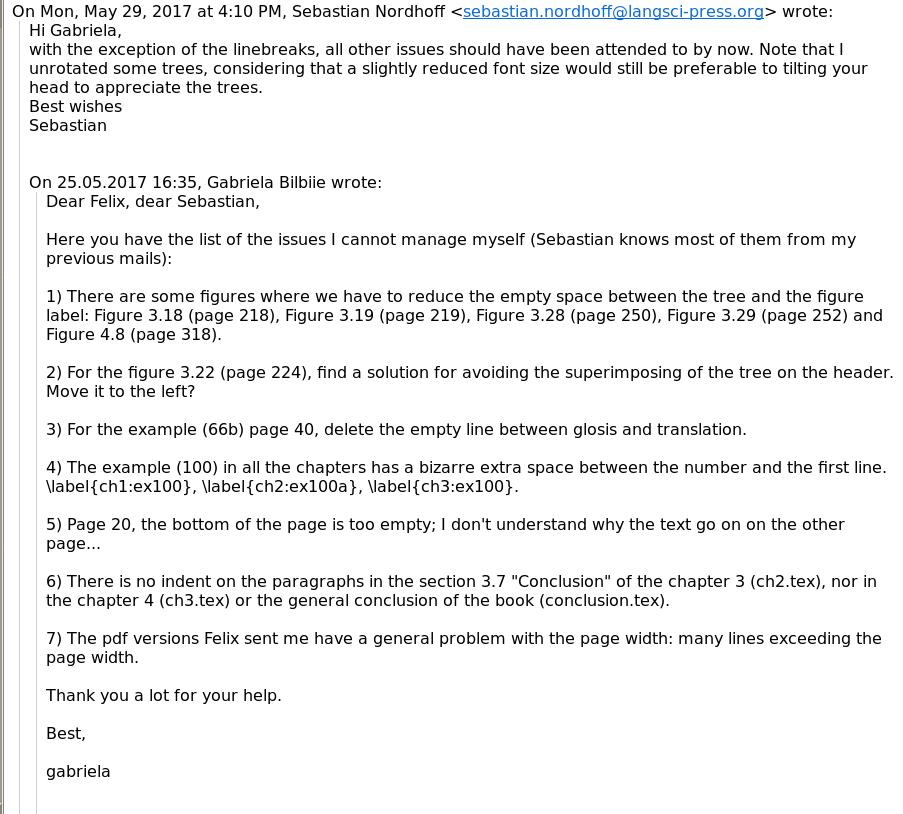 The author is working on the manuscript at the same time as Sebastian and Felix from LangSci. She lists things she cannot do herself, which are then being taken care of by LangSci. This works well for a monograph since the author knows exactly what she is trying to accomplish. It is more difficult for an edited volume, where the volume editor might not have a very clear idea which elements of a problematic diagram/tree have to be where they are at all costs, and which other elements could be moved/rotated/reduced in size.
The author is working on the manuscript at the same time as Sebastian and Felix from LangSci. She lists things she cannot do herself, which are then being taken care of by LangSci. This works well for a monograph since the author knows exactly what she is trying to accomplish. It is more difficult for an edited volume, where the volume editor might not have a very clear idea which elements of a problematic diagram/tree have to be where they are at all costs, and which other elements could be moved/rotated/reduced in size.
The following is an exchange from Diversity in African languages. Note that there is a separation of labour between fixing typos and formatting (volume editor Doris) and fixing references and example alignment (Sebastian from Language Science Press).
 For some volumes, chapter authors have directly edited their chapter on Overleaf themselves.
For some volumes, chapter authors have directly edited their chapter on Overleaf themselves.
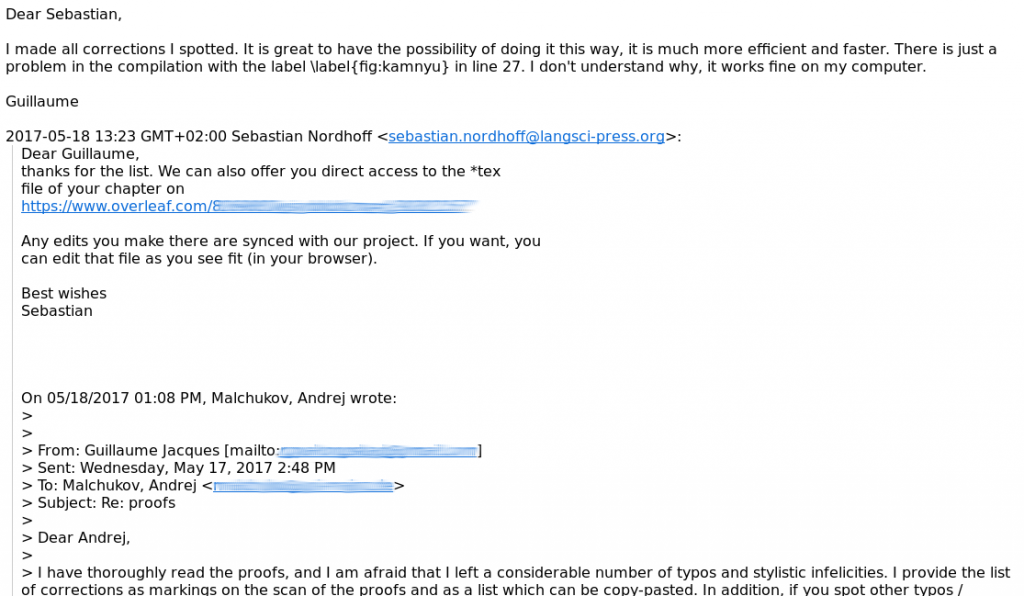 This should be done in close coordination with the LangSci office since there are some risks of side-effects.
This should be done in close coordination with the LangSci office since there are some risks of side-effects.
In a way, this approach could be called “Continuous proofing”, which differs from the traditional 2-stage proofing. (Software developers might notice some relation to Continuous Integration.) When both sides are satisfied with the end product, the book will be published. There will be as many iterations as desired. The following is a mail exchange over 3 days about a map
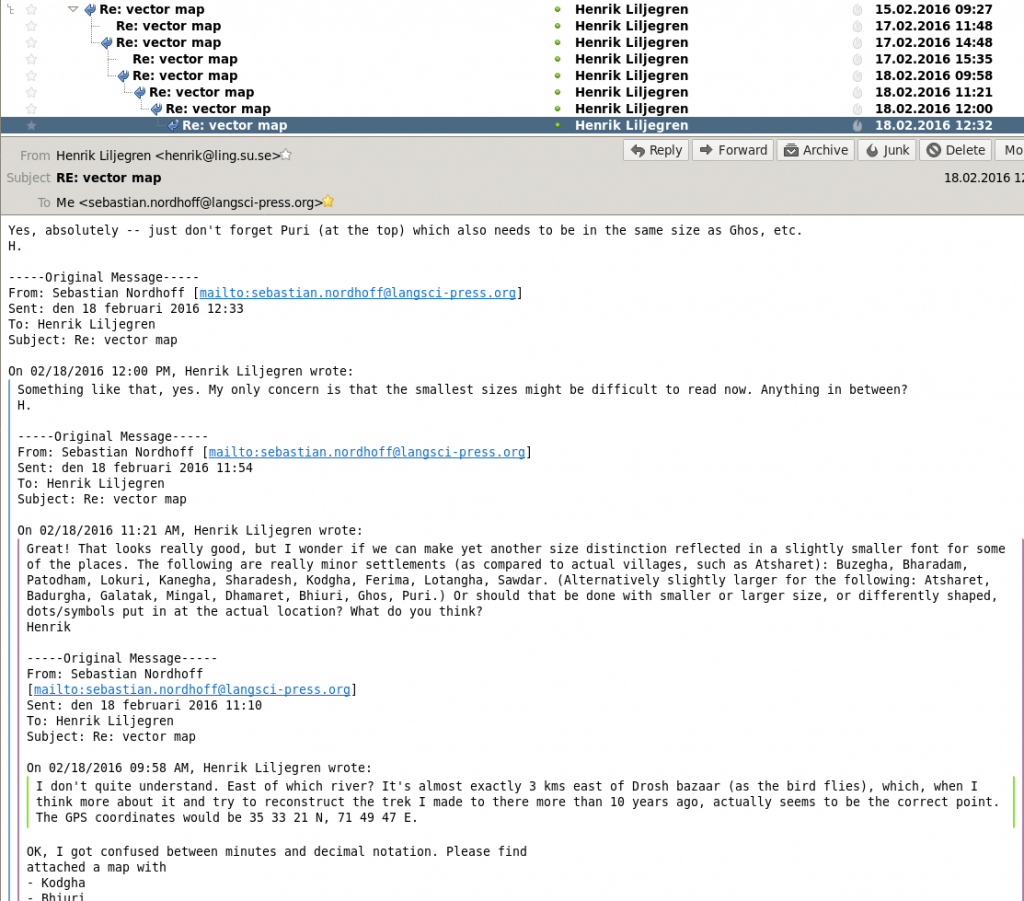 So, the take-home message of this is probably that a) LangSci books are produced in an iterative manner and b) that volume editors have to find a good way how to involve their chapter authors in this process. This can either be done by inviting them to the Overleaf platform, or by sending them pdfs of ‘their’ chapters when relevant. Both approaches have been used in the past.
So, the take-home message of this is probably that a) LangSci books are produced in an iterative manner and b) that volume editors have to find a good way how to involve their chapter authors in this process. This can either be done by inviting them to the Overleaf platform, or by sending them pdfs of ‘their’ chapters when relevant. Both approaches have been used in the past.
Community proofreading
Another aspect where LangSci differs is community proofreading. When a book is available in its revised version, it is announced to our list of 250 community proofreaders. Typically, about 15 people volunteer to read one or more chapters of the volume under discussion. Proofreaders are acknowledged in our Hall of Fame. The proofreaders then get assigned a chapter. They usually leave their comments on Paperhive, e.g. here for Diversity in African languages
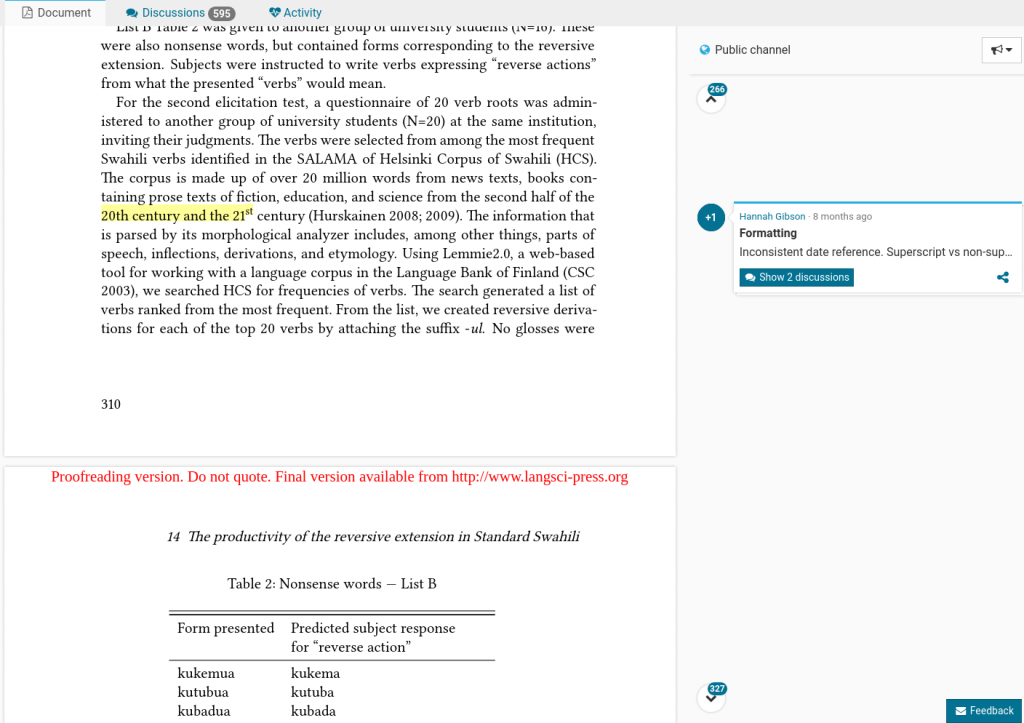 The volunteers would normally read the book anyway after publication, so they are happy to get a “sneak preview”. This also means that they have an intrinsic motivation to contribute and make the paper better and often provide very detailed feedback on particular language-specific detail. On the other hand, they sometimes have differing interpretations of some aspects of the guidelines. This means that some comments might not seem pertinent. In those cases, it is perfectly fine for the volume editor/author to disregard these comments. We do believe that having “real” readers read the papers will show the passages “real” readers will find difficult, rather than pointing out instances of Oxford commas or non-restrictive which, which belong more to the realm to Publisherese.
The volunteers would normally read the book anyway after publication, so they are happy to get a “sneak preview”. This also means that they have an intrinsic motivation to contribute and make the paper better and often provide very detailed feedback on particular language-specific detail. On the other hand, they sometimes have differing interpretations of some aspects of the guidelines. This means that some comments might not seem pertinent. In those cases, it is perfectly fine for the volume editor/author to disregard these comments. We do believe that having “real” readers read the papers will show the passages “real” readers will find difficult, rather than pointing out instances of Oxford commas or non-restrictive which, which belong more to the realm to Publisherese.
We have been moving our proofreading to Paperhive, and typically, there are about 1000 comments for an edited volume. The volume editor has to decide how to incorporate the comments. Will she have the authors do it? Will she take care of trivial cases herself and get back to the authors only in cases she cannot resolve? How will authors vet any changes? Very many different setups have been chosen in the past. For a prospective volume editor, it is probably a good idea to give this some thought early on and consult with the LangSci office if necessary.
Bibliographies
We will require the use of citation managers like Zotero for edited volumes in the future.
Experience shows that, otherwise, authors cite works which are not in their list of references; cite works with year 1999, but list year 1998 in the references; include references which are not cited at all; include works with incomplete information etc. The use of a citation manager prevents this. Chapter authors will advance that they will be able to cope without a citation manager. There is now ample empirical evidence from our edited volumes that this is not true. Failure to use a citation manager will inevitably lead to dangling or unclear references, which require a lot of emailing back and forth to resolve. It is my guess that cleaning up bibliographies takes up about 30% of the work for an edited volume, so you really want your bibliography to be in good shape right from the beginning. Saves you days if not weeks for other stuff.
Workflow
The following list sums up the workflow for an edited volume. Please note the different available procedures for reviewing edited volumes.
- initial submission of papers
- reviewing
- acceptance/rejection of papers
- revised papers
- conversion to Latex. (Technically, a task for the editor, but assistance is given. Typically, LangSci will do a rough conversion and postprocessing is done by the volume editors. Depending on the heterogeneity and idiosyncrasy of the original papers, this can be very time consuming. The closer the initial papers follow the templates and the stylesheet, the less time-consuming this will be.)
- (vetting by authors)
- proofreading
- indexing (can be done in parallel with proofreading)
- incorporation of proofreaders’ comments
- (vetting by authors)
- final typesetting
- approval by volume editor and signing of contract
- approval by series editor
- approval by press directors
- preparation of print-on-demand
- publication as pdf and print (+various online venues)
- announcement
Recommendations
In order to assure a smooth production of your edited volume, the following recommendations are given:
- instruct your authors to USE THE TEMPLATES, and ADHERE TO THE GUIDELINES. Every deviation from this will lead to EXTRA WORK FOR YOU.
- instruct your authors to use a CITATION MANAGER. Failure to do so will lead to A LOT OF EXTRA WORK FOR YOU.
- think about how authors should be involved in the book production process. Will you edit at their request, or will they edit themselves? What are the stages of the publication process where authors will vet the current status of their contribution?
- If you have any doubts or run into any technical problems, contact support early. Typically, we can provide an answer in a couple of minutes.

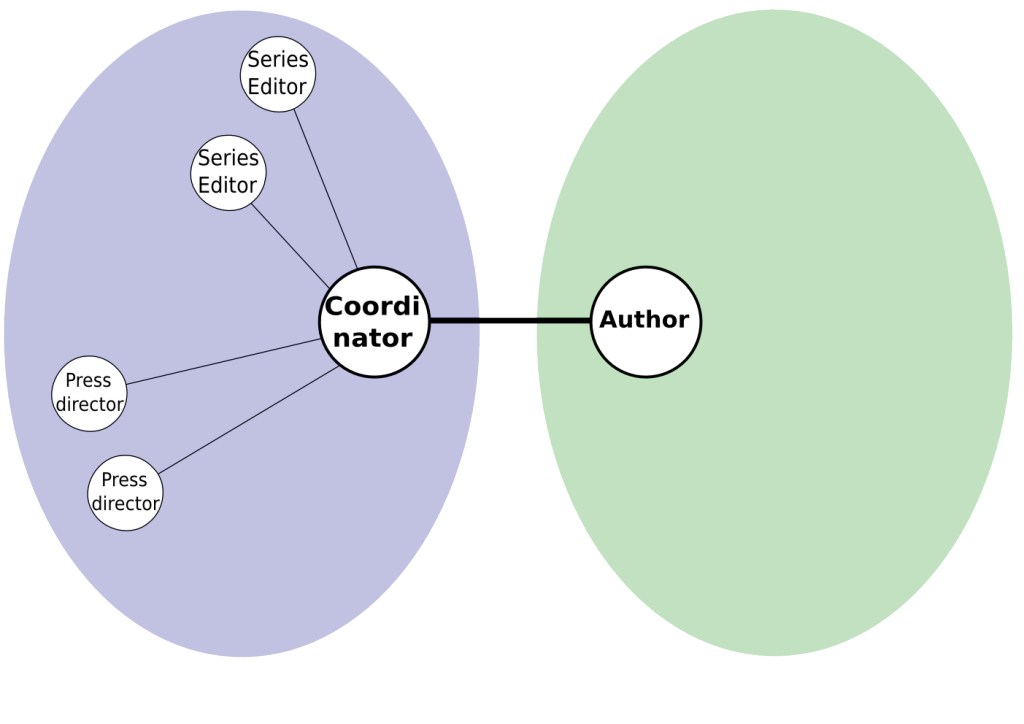
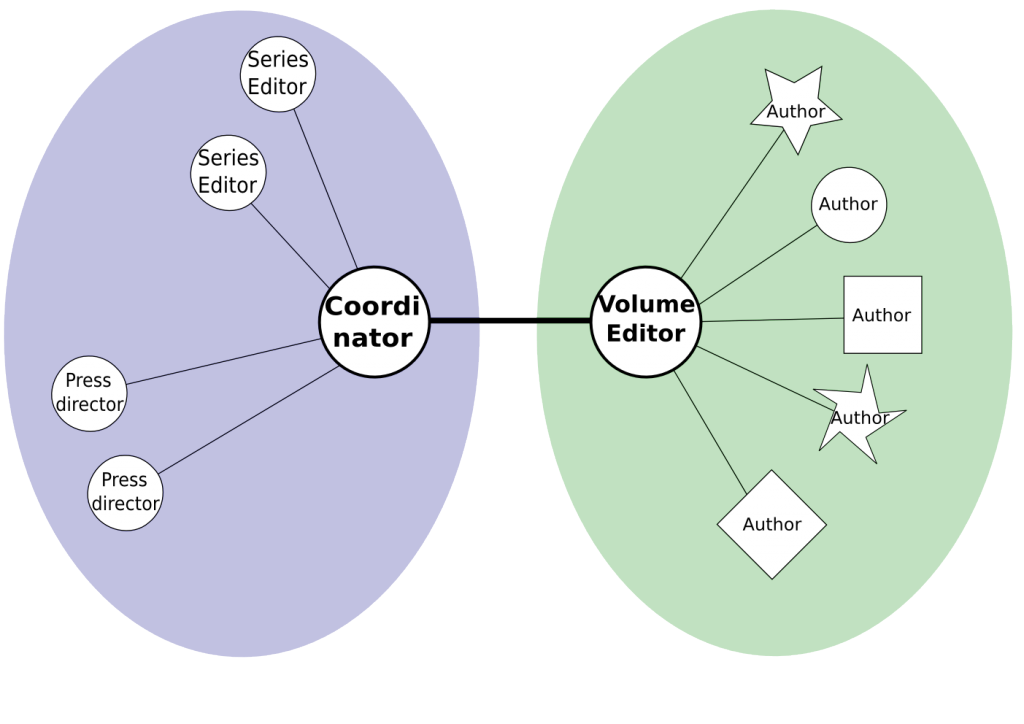
Thanks for this post, Sebastian! You might have talked about this before, but: Concerning edited volumes – is there a possibility of having individual papers gradually appear, as they get ready? This is a policy taken by some journals for their special issues. And it increases the motivation for authors to work on their papers as quickly as possible (essentially, it completely removes the “vicious circle” issue you mention).
Thanks for this suggestion. There are a number of difficulties, though:
– proofreading is done for whole volumes. We cannot take out individual chapters and have them proofread beforehand
– pagination is important for the printed books. Many eJournals do not have any pagination at all, but for us, this is not an option. If we published chapter 7 before the other chapters, the page numbers for chapter 7 are still likely to change.
Neither of these issues is impossible to overcome, but for the time being, we do not have the setup to cater for publication of individual chapters